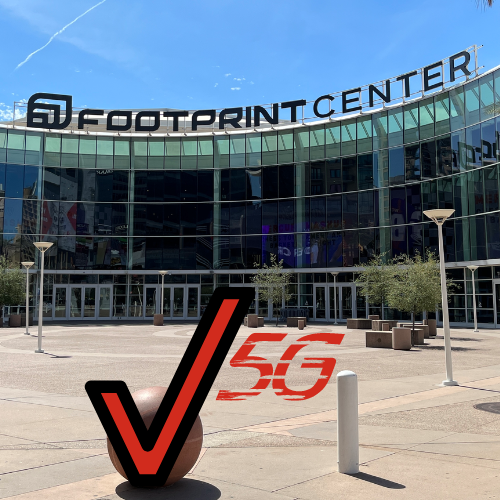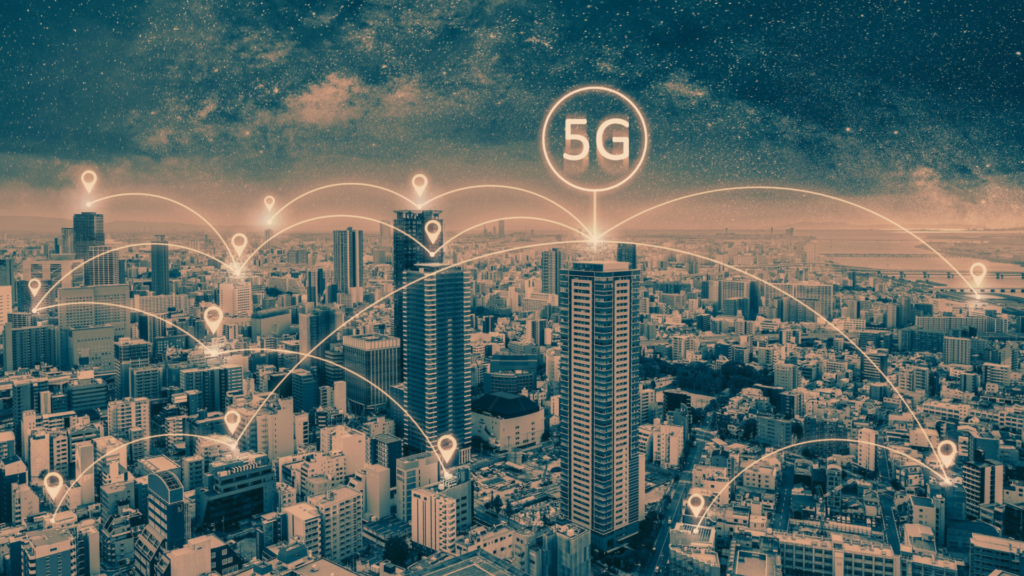Verizon, the network America relies on, and Ericsson to demonstrate the latest 5G innovations at the Footprint Center on December 6

BASKING RIDGE, NJ – December 1, 2022 (Verizon Wireless) – Verizon Business will demonstrate the transformative benefits of its business solutions at the next installment of its 5G Innovation Sessions series, occurring at the Footprint Center on December 6. Executives from Verizon, Ericsson, the Phoenix Suns/Phoenix Mercury, Ticketmaster, Amazon Web Services (AWS), and the City of Phoenix will demonstrate a range of forward-looking scenarios that leverage the power of 5G and Mobile Edge Computing, including real-time container tracking, collaboration robots, video scene analytics monitoring manufacturing assembly, real-time crowd analytics, interactive cityscapes, and Verizon Frontline’s Tactical Humanitarian Operations Response (THOR) and Mobile Utility Technology Transport (MUTT) vehicles. The program includes dynamic demonstrations by Verizon and Ericsson, speaker segments, and panel discussions.
“5G presents a once-in-a-generation opportunity for businesses to supercharge productivity and innovation and gain an edge on the competition,” said TJ Fox, Senior Vice President, Industrial IoT & Automotive, Verizon Business. “The purpose of these sessions is to make sure businesses know how to take advantage of the capabilities that 5G enables, including a broad range of edge-computing and private-network applications that they might not be aware of. It’s all on full display at the 5G Innovation Session in Phoenix.”
The event will be held at the Footprint Center, located at 201 E. Jefferson St. Phoenix, AZ 85004 in Phoenix, featuring several prominent executives including:
- TJ Fox, Senior Vice President and President, Industrial IoT and Automotive, Verizon Business;
- Maggie Hallbach, President, Verizon Frontline, Verizon Business;
- Mike Ruhnke, Vice President, US Corporate Enterprise Accounts, Verizon Business;
- Danny Johnson, Director, Product Marketing, Verizon Business;
- Dave Hickey, Vice President, West Business Markets, Verizon Business;
- Cory Davis, Assistant Vice President, Public Safety, Verizon Frontline, Verizon Business;
- Mitch Cooper, Vice President of Sales for Verizon, Ericsson North America;
- Peter Linder, Head of 5G Marketing, Ericsson North America;
- Dan Costello, Executive Vice President and Chief Revenue Officer, Phoenix Suns;
- Steve Reese, Chief Information Officer, Phoenix Suns;
- Mayor Kate Gallego, City of Phoenix;
- Kara Kalkbrenner, Retired Fire Chief, City of Phoenix;
- Kurt Schwartzkopf, Executive Vice President, Co-Head of Sports, NBA & NHL Arenas, Ticketmaster;
- Anil Lalwani, Principal Product Manager, AWS
“We’re living in a remarkable period of innovation in both public safety and government,” said Maggie Hallbach, President of Verizon Frontline and Senior Vice President of Verizon Public Sector. “While in Phoenix, I’m looking forward to discussing and demonstrating just some of the transformative capabilities that our 5G network can unlock for our partners in the public sector, including the more than 30,000 public safety agencies nationwide that trust Verizon Frontline to provide reliable, mission-critical connectivity.”
“The low latency, built-in security, blazing fast speed and unmatched capacity that 5G can enable are bringing new capabilities and use cases to a wide range of industries,” said Mitch Cooper, Vice President of Sales for Verizon at Ericsson North America. “These sessions are a chance for people to see the power of these networks in person, and to imagine the possibilities 5G can bring to their businesses.”
To register for the Phoenix event, use this event link.
Verizon’s Commitment to Phoenix
In 2022, Verizon deployed 5G Ultra Wideband using C-band spectrum in many areas throughout Phoenix, adding coverage and capacity to serve customers throughout the Valley. Additionally, Verizon deployed 5G Ultra Wideband using mmWave spectrum strategically in Phoenix and neighboring cities like Tempe, Chandler and Scottsdale to increase performance and capacity. To manage increases in data usage and provide an enhanced experience at specific venues, Verizon engineers have replaced and enhanced the in-building system at the Phoenix Suns’ Footprint Arena in downtown Phoenix and in several hotels throughout the Valley, and engineers are deploying enhancements at the Phoenix Convention Center. Additionally, to meet the changing patterns of when and how customers use their devices, Verizon engineers in Phoenix have deployed additional 4G carriers to increase capacity in areas throughout the community.
Over the last decade, working through nonprofit partners and a suite of programs and resources, Verizon Innovative Learning has committed $1 billion in market value to support digital equity and inclusion within education for some of the most vulnerable populations across the country. The initiative is celebrating 10 years of providing free technology, internet access and resources to schools and educators across America, including Title I schools.
In Phoenix, over 15,000 students have been reached across 19 schools through the Verizon Innovative Learning Schools program. This academic year, the program welcomed over 2,000 new students in the Roosevelt, Pendergast, Cartwright, Alhambra and Issac Elementary School Districts.
Additionally, all educators and students have access to Verizon Innovative Learning HQ, our free next-gen online education portal that provides XR content, professional development, and lesson plans. These efforts are part of Citizen Verizon, the company’s responsible business plan for economic, environmental and social advancement. Through Citizen Verizon, the company has a goal to provide 10 million youths with digital skills training by 2030.
Verizon realizes the importance of technology in helping small businesses succeed, which is why the company has a goal to support 1M small businesses by 2030. Verizon Small Business Digital Ready, a free online curriculum, was designed to give small businesses the tools they need to thrive in today’s digital economy, including access to personalized lesson plans, coaching from experts and networking opportunities with diverse, industry-specific businesses. Since launch in September 2021, more than 1,400 Phoenix-based businesses have been onboarded to the program.
Verizon announced today the availability of Spanish-language course offerings. Hispanic-owned small businesses can now access Spanish curriculum, coaching from experts, community events and personalized mentorship, as well as apply to receive a $10,000 grant as part of a $250,000 fund to help further support minority small businesses as part of Verizon Small Business Digital Ready.
Supporting first responders who serve Phoenix
During 2021, the Verizon Frontline Crisis Response Team deployed multiple times in support of public safety agencies in Arizona to provide mission-critical communications capabilities to the first responders on the front lines of emergency response operations.
Verizon Frontline devices and solutions ranging from mobile hotspots, routers and smart devices to deployable satellite solutions, such as Satellite Picocells on Trailers (SPOTs), were deployed in support of Arizona first responders.
This support has continued during 2022, as the Verizon Frontline Crisis Response Team has already participated in several public safety operations and training events alongside Arizona public safety agencies including deployments in support of wildland firefighters. This ongoing support is provided at no cost to local agencies and represents a continuation of Verizon Frontline’s commitment to investing and innovating in partnership with public safety and government.
Switch to the network Phoenix relies on
Because Verizon is the network Phoenix relies on, we’ve made it easy to switch with our new Welcome Unlimited plan – our best unlimited price ever for unlimited talk, text, and data on Verizon’s 5G Nationwide network. Looking to switch the whole family? Welcome Unlimited starts at just $30 per line (Auto Pay & paper-free billing required) per month for four lines (plus taxes and fees, with Auto Pay). You can learn more at verizon.com/plans.
About the 5G Innovation Sessions
Verizon’s 5G Innovation Sessions have so far taken place in Atlanta (July), Houston (August), Boston (September), Los Angeles (October) and New York City (November). The events cover a range of themes, including Managed Venue, Fixed Wireless Access, Private 5G, and Mobile Edge Compute.



